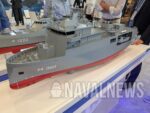India is accelerating development of its first nuclear-powered aircraft carrier—INS Vishal—as part of a broader strategy to assert maritime dominance in the Indo-Pacific and counterbalance China’s expanding naval footprint. The project marks a major leap in indigenous naval capability and signals India’s intent to operate true blue-water carrier strike groups with extended reach and endurance.
INS Vishal: Conceptual Shift Toward Nuclear Propulsion
The proposed INS Vishal (also referred to as Indigenous Aircraft Carrier-2 or IAC-2) represents a conceptual departure from India’s previous conventionally powered carriers. Unlike the 45,000-tonne INS Vikrant (IAC-1), which was commissioned in 2022 with gas turbine propulsion, INS Vishal is expected to displace over 65,000 tonnes and feature nuclear propulsion for sustained high-speed operations without dependence on refueling logistics.
According to multiple Indian defense sources including statements from the Defence Research and Development Organisation (DRDO) and Naval Design Bureau (NDB), the nuclear propulsion system will likely be developed indigenously with support from the Bhabha Atomic Research Centre (BARC). The envisioned design includes:
- Displacement: ~65,000–70,000 tonnes
- Propulsion: Two or more pressurized water reactors (PWRs)
- Flight deck configuration: CATOBAR (Catapult Assisted Take-Off But Arrested Recovery)
- Aircraft complement: Up to 55 fixed-wing aircraft and helicopters
The CATOBAR system would allow launching heavier aircraft such as AEW&C platforms and future unmanned combat aerial vehicles (UCAVs). India has reportedly engaged with U.S. defense firms like General Atomics for potential EMALS (Electromagnetic Aircraft Launch System) technology transfer discussions since at least 2017.
Strategic Imperatives Behind the Carrier Program
The decision to pursue a nuclear-powered carrier stems from India’s evolving maritime threat perception. With China rapidly expanding its naval footprint via bases in Djibouti and Gwadar under its Belt and Road Initiative—and deploying aircraft carriers like Liaoning and Shandong—the Indian Navy views power projection as critical for regional deterrence.
The Indian Navy’s Maritime Capability Perspective Plan (MCPP) envisions a three-carrier fleet by the early 2030s to ensure continuous availability of at least two operational carriers—one each for eastern and western seaboards. A nuclear-powered INS Vishal would provide persistent presence across key chokepoints such as the Malacca Strait and Andaman Sea while supporting expeditionary operations into the South China Sea if required.
Additionally, Pakistan’s acquisition of Chinese-origin Type 054A/P frigates and Hangor-class submarines underscores the need for enhanced sea control capabilities in the Arabian Sea. A nuclear carrier offers longer operational endurance compared to conventionally powered ships—a decisive factor during high-tempo operations or blockades.
Program Status, Timelines, and Challenges
The IAC-2 program has been under conceptual development since at least 2015 but faced delays due to budgetary constraints and inter-service prioritization debates. In late 2023, reports emerged that India’s Ministry of Defence had approved initial funding for pre-project activities including feasibility studies on reactor integration and hull design optimization.
Key milestones expected over the next decade include:
- 2025–2026: Finalization of design specifications by NDB
- 2027–2028: Steel cutting & keel laying at Cochin Shipyard Limited (CSL)
- 2035–2037: Sea trials followed by commissioning into active service
Cochin Shipyard—already experienced from building INS Vikrant—is likely to be tasked again with construction. However, integrating a compact naval reactor into an aircraft carrier hull remains an unprecedented challenge for India’s shipbuilding ecosystem. While India has experience operating nuclear submarines like INS Arihant using PWRs (~83 MW), scaling this technology up safely for surface vessels requires significant R&D investment.
Aviation Component: Indigenous Fighters vs Foreign Options
The air wing of INS Vishal will be central to its combat effectiveness. The Indian Navy currently operates MiG-29K fighters aboard INS Vikramaditya but has expressed dissatisfaction with their reliability. For IAC-2’s CATOBAR deck configuration, heavier multirole fighters will be needed.
Candidates include:
- Boeing F/A-18E/F Super Hornet: Successfully demonstrated ski-jump compatibility; CATOBAR-capable; U.S.-origin may ease EMALS integration.
- Dassault Rafale M: Already shortlisted; commonality with IAF’s Rafale fleet; proven naval variant.
- TEDBF (Twin Engine Deck-Based Fighter): Indigenous program by HAL/DRDO; projected readiness post-2031; intended long-term solution but not available near-term.
An interim foreign acquisition appears likely until TEDBF matures. Additionally, DRDO is pursuing development of unmanned deck-based systems including UCAV demonstrators under Project Ghatak that could eventually operate from IAC-2 using CATOBAR launch mechanisms.
Nuclear Safety Protocols & Operational Implications
Nuclear propulsion introduces complex safety requirements both during peacetime port calls and wartime operations. India will need robust radiation shielding protocols aboard ship as well as training infrastructure for reactor crew certification. Lessons from submarine operations will inform these procedures but adapting them for surface vessels poses new challenges—including vulnerability mitigation against anti-ship missiles targeting reactor compartments.
If successful, INS Vishal would significantly elevate India’s ability to project power far beyond its littoral waters—comparable only to navies fielding supercarriers such as those operated by the U.S., France or China’s upcoming Type 003 class Fujian carrier. It would also enable sustained deployment of carrier strike groups supported by destroyers like Visakhapatnam-class DDGs equipped with BrahMos missiles and Kolkata-class air defense assets.
Conclusion: A Strategic Leap Amid Regional Rivalries
The development of a nuclear-powered aircraft carrier represents more than just technological ambition—it reflects India’s strategic calculus amid intensifying competition in Asia’s maritime domain. While timelines remain long-term given technical complexity and fiscal demands, formal movement on IAC-2 signals New Delhi’s commitment toward achieving true blue-water capability aligned with its status as a regional security provider.
If realized within projected timelines by mid-to-late 2030s, INS Vishal could become one of Asia’s most formidable naval platforms—offering India unmatched flexibility across deterrence missions ranging from HADR (Humanitarian Assistance & Disaster Relief) to high-end peer conflict scenarios involving both Pakistan or Chinese PLAN assets in contested waters.









